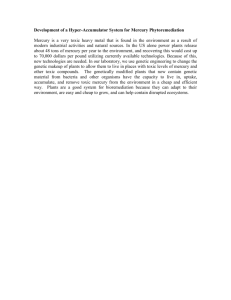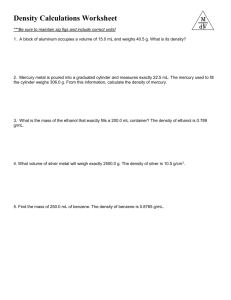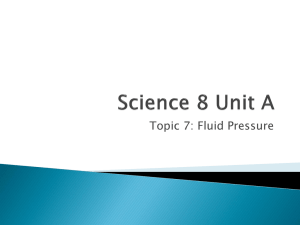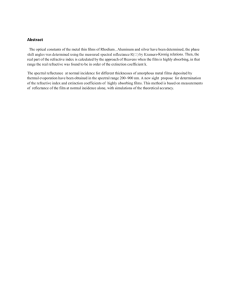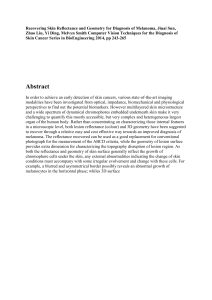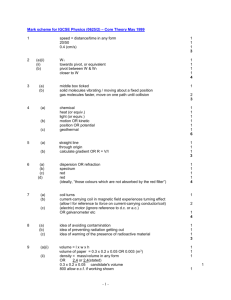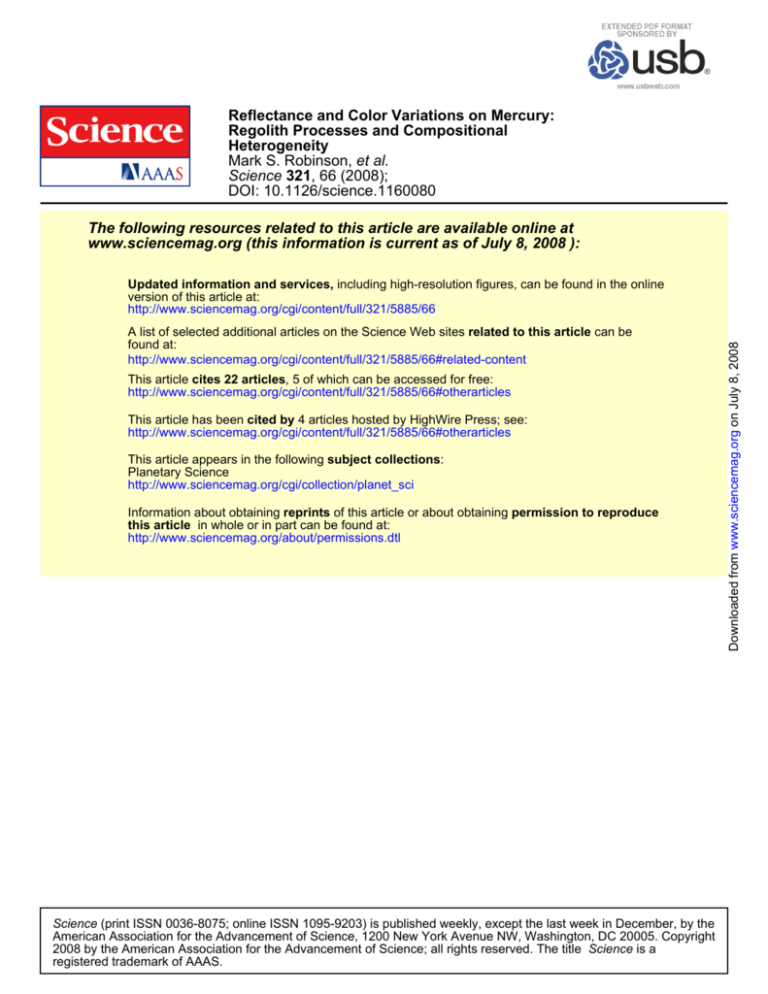
Reflectance and Color Variations on Mercury:
Regolith Processes and Compositional
Heterogeneity
Mark S. Robinson, et al.
Science 321, 66 (2008);
DOI: 10.1126/science.1160080
The following resources related to this article are available online at
www.sciencemag.org (this information is current as of July 8, 2008 ):
A list of selected additional articles on the Science Web sites related to this article can be
found at:
http://www.sciencemag.org/cgi/content/full/321/5885/66#related-content
This article cites 22 articles, 5 of which can be accessed for free:
http://www.sciencemag.org/cgi/content/full/321/5885/66#otherarticles
This article has been cited by 4 articles hosted by HighWire Press; see:
http://www.sciencemag.org/cgi/content/full/321/5885/66#otherarticles
This article appears in the following subject collections:
Planetary Science
http://www.sciencemag.org/cgi/collection/planet_sci
Information about obtaining reprints of this article or about obtaining permission to reproduce
this article in whole or in part can be found at:
http://www.sciencemag.org/about/permissions.dtl
Science (print ISSN 0036-8075; online ISSN 1095-9203) is published weekly, except the last week in December, by the
American Association for the Advancement of Science, 1200 New York Avenue NW, Washington, DC 20005. Copyright
2008 by the American Association for the Advancement of Science; all rights reserved. The title Science is a
registered trademark of AAAS.
Downloaded from www.sciencemag.org on July 8, 2008
Updated information and services, including high-resolution figures, can be found in the online
version of this article at:
http://www.sciencemag.org/cgi/content/full/321/5885/66
REPORT
Reflectance and Color Variations
on Mercury: Regolith Processes
and Compositional Heterogeneity
Mark S. Robinson,1* Scott L. Murchie,2 David T. Blewett,2 Deborah L. Domingue,2
S. Edward Hawkins III,2 James W. Head,3 Gregory M. Holsclaw,4 William E. McClintock,4
Timothy J. McCoy,5 Ralph L. McNutt Jr.,2 Louise M. Prockter,2
Sean C. Solomon,6 Thomas R. Watters7
Multispectral images of Mercury obtained by the MESSENGER spacecraft reveal that its
surface has an overall relatively low reflectance with three large-scale units identified on the
basis of reflectance and slope (0.4 to 1.0 micrometer). A higher-reflectance, relatively red material
occurs as a distinct class of smooth plains that were likely emplaced volcanically; a lowerreflectance material with a lesser spectral slope may represent a distinct crustal component
enriched in opaque minerals, possibly more common at depth. A spectrally intermediate terrain
probably forms most of the upper crust. Three other spectrally distinct but spatially restricted
units include fresh crater ejecta less affected by space weathering than other surface materials;
high-reflectance deposits seen in some crater floors; and moderately high-reflectance, relatively
reddish material associated with rimless depressions.
he MESSENGER spacecraft encountered
Mercury on 14 January 2008, and the
Mercury Dual Imaging System (MDIS)
(1) acquired monochrome, 0.75-mm narrowangle camera (NAC) and 11-color, 0.4- to 1.0-mm
wide-angle camera (WAC) images of parts of
Mercury never before seen by a spacecraft. We
used WAC color observations (~5 km/pixel) in
conjunction with NAC high-resolution (~200 to
500 m/pixel) monochrome images to explore
the dominant sources of spectral heterogeneity
T
on Mercury's surface and their correlation with
morphologic features.
Early ground-based observations showed that
Mercury had a low disk-integrated reflectance
and a relatively featureless, positively sloping spectrum across the visible to near-infrared (near-IR)
wavelengths (2). The lack of resolvable near-IR
absorptions led to the conclusion that Mercury’s
surface is low in ferrous iron (3–5). Reflectance
and mid-IR emission spectroscopy led to the hypothesis that Mercury’s upper crust is predomi-
Fig. 1. MDIS WAC departure color sequence
(EW0 10882 9678 EW0108829728C). (A)
Photometrically corrected 560-nm-filter image. Largest reflectance
contrasts are related to
immature crater materials, the Caloris smooth
plains (C), and Tolstoj
basin (t) LRM. White box
indicates standard spectral area used to normalize extracted spectra (Fig.
3A). (B) PC2 delimits regions with greatest color differences. Caloris
smooth plains (C) and
ejecta associated with
Tolstoj basin (T) exhibit the greatest contrasts not associated with maturity
variations. Low-reflectance craters (white arrows) in Caloris basin have the
same high values in the PC2 image as Tolstoj ejecta (black arrows). (C) Color
composite of spectral parameters used to separate units. Red is the inverse
of PC2, green is PC1, and blue is relative visible color (430-nm/560-nm
66
4 JULY 2008
VOL 321
nantly composed of plagioclase feldspar, likely
with lesser amounts of low-iron pyroxene (enstatite and diopside) and olivine (forsterite) (4, 6, 7).
The surface of Mercury is expected to be heavily altered through space weathering processes
that suppress absorption features, lower reflectance, and increase spectral slope (redden the
spectrum), thus complicating interpretations of
spectral data (8). Optically immature materials
that are excavated as ejecta and rays from young
craters are typically found in deposits less than
100 km in diameter. These smaller deposits contain
the less-altered spectral signature of underlying
rock and thus provide more definitive information about the composition of the crust and the
nature of space weathering processes. The Mariner
10 spacecraft provided the first high-resolution
panchromatic and color observations of Mercury
(3). Similarly to the Moon, crater rays exhibited
higher reflectance and shallower slope at visible
wavelengths, indicating that space weathering
processes operated on Mercury (3, 9, 10). A
major surprise from the Mariner 10 multispectral observations was the lack of reflectance contrast between Mercury’s smooth plains, which
resemble lunar maria, and the adjacent terrain
1
School of Earth and Space Exploration, Arizona State University, Tempe, AZ 85287, USA. 2Johns Hopkins University
Applied Physics Laboratory, Laurel, MD 20723, USA. 3Department of Geological Sciences, Brown University, Providence, RI
02912, USA. 4Laboratory for Atmospheric and Space Physics,
University of Colorado, Boulder, CO 80303, USA. 5National
Museum of Natural History, Smithsonian Institution, Washington, DC 20560–0119, USA. 6Department of Terrestrial Magnetism, Carnegie Institution of Washington, Washington DC,
20015, USA. 7National Air and Space Museum, Smithsonian
Institution, Washington, DC 20013, USA.
*To whom correspondence should be addressed. E-mail:
robinson@ser.asu.edu
ratio). Unlabeled white arrows and irregular polygon indicate relatively
young smooth plains deposits that exhibit clear spectral boundaries with
basement materials (similar to Caloris plains, C), here interpreted to be
volcanic in origin. Tsp denotes HRP within Tolstoj. Black arrows indicate red
units interpreted as small volcanic centers.
SCIENCE
www.sciencemag.org
Downloaded from www.sciencemag.org on July 8, 2008
MESSENGER
SPECIALSECTION
tions in physical state or chemistry (Fig. 1B). To
isolate color differences further, we computed
color ratios and compared them with the PC maps.
We determined distinct regions from these parameter maps (Fig. 1) and extracted representative spectra for analysis (Fig. 3).
MDIS revealed previously unimaged terrain
whose reflectance and color properties are similar to those of the region imaged by Mariner 10
(10–12). The three areally dominant spectral units
are low-reflectance material (LRM), moderate-tohigh-reflectance smooth plains (HRP), and spectrally intermediate terrain (IT). The three units
differ primarily in reflectance and share a red,
lunar-like spectral slope indicative of mature,
space-weathered soils. LRM (as much as ~30%
lower than average reflectance) is widespread
(Figs. 1 and 2); the most conspicuous exposures
are found in the Tolstoj basin region (Fig. 2D),
on some craters—most notably within the Caloris
basin (Fig. 1, Fig. 2B)—and in the southern,
heavily cratered parts of the newly imaged region (Fig. 1). In some instances, impact events
excavated LRM from depth, and this material
can be traced outward from the crater in the
ejecta blanket (Fig. 2, C, E, and F). In all instances, the LRM has a moderate to shallow
spectral slope (Fig. 3) and a shallow minimum
Fig. 2. (A) Basho crater (64-km diameter). High-reflectance ray material likely represents immature
material, whereas the LRM near
the rim may represent immature
material of a different composition
(EN0108828233M). (B) Two impact
craters with low-reflectance walls found
within the Caloris basin. Sander crater
(upper right, 50-km diameter) exhibits
BCFDs (EN0108826687M). (C) Linear
streamers (unlabeled arrows) at
Mozart crater (215-km diameter)
trace LRM excavated during the impact. Exposures of the same material
are visible in the crater wall (W arrows) and in the central peak ring (P)
(EN0108827022M). (D) Tolstoj HRP
(SP) superposed on LRM (arrows); image 825 km wide (EN0108828337M,
EN0108828342M). (E) Color parameter image highlighting complex
color relations. White arrows indicate
color anomaly associated with LRM
streamers at Mozart crater. Rayed
crater at lower left illustrates common occurrence of redder material
(black arrow) on the rim of immature
craters; image ~800 km wide. (F)
Western boundary of Caloris HRP
(arrows) and basin rim. Note the radial
color texture in the lower reflectance
annular plains; image ~600 km wide
[frame numbers and color scheme
for (E) and (F) in Fig. 1 caption]. North is toward the top in all images.
www.sciencemag.org
SCIENCE
VOL 321
near 600 nm. A broad annulus of somewhat dark
material exterior to the Caloris basin is ~10%
lower in reflectance than the planetary average,
with complex interfingered IT and LRM occurrences. Several large craters within the Caloris
basin are composed of LRM, indicating that a
substantial portion of the material beneath the basin interior smooth plains is also LRM. This annulus of mixed material is approximately equivalent
to previously mapped basin ejecta facies (15).
However, crater counts for a portion of the annulus show that its age is less than that of the Caloris
interior plains (16). HRP, exemplified by those
plains that cover the floor of the Caloris basin,
typically have reflectances ~10% above the hemispheric average and exhibit a slightly steeper
(redder) spectral slope. Most of the heavily cratered terrain has reflectance properties intermediate to those between those of HRP and LRM.
Three other spectrally distinct but spatially
restricted units are also recognized: fresh crater
ejecta, bright crater-floor deposits (BCFDs), and
moderately high-reflectance relatively reddish
material (red spots) associated with rimless depressions. The immature crater ejecta are materials with reflectance elevated as much as 70%
above IT and are associated with the walls, floors,
and rays of young impact craters (Fig. 2A). These
higher-reflectance materials also have a less-red
spectral slope (Fig. 3), as do fresh lunar crater
materials (9, 10), suggesting that their optical
properties have been less affected by space
weathering. The BCFDs occur in distinct patches
with abrupt boundaries and are found within
only a few craters (Fig. 2B). Unlike fresh crater
ejecta, the BCFD units do not appear to be associated with exposure of fresh material from
the impact that formed the host crater. Similar
bright floor deposits were identified in Mariner
10 images (17, 18). This same material is also
found in massifs of the peak rings of Raditladi
and Eminescu basins. The peak-ring massifs
are surrounded by aureoles of comparable highreflectance material that extend radially for several
kilometers. The red spots have elevated reflectances (up to 30% above average), occurring as
diffuse halos surrounding scalloped-edged, rimless depressions along the margin of Caloris
basin (19, 20) and in the interiors of several
craters of the southern heavily cratered terrain.
These latter materials are distinguished from freshcrater and BCFD materials by their spectral slope,
which is the reddest observed by MESSENGER.
Mariner 10 also observed materials with similar
spectral characteristics, the most conspicuous
found in the crater Lermontov (10, 11, 18), but
central depressions were seen in only one (10).
A consistent attribute of spectra of all of the
units is a lack of evidence for an absorption near
1-mm due to ferrous iron in silicates (Fig. 3A).
WAC imaging has a spatial resolution two orders
of magnitude higher than ground-based spectra,
and it resolves fresh impact materials. To under-
4 JULY 2008
Downloaded from www.sciencemag.org on July 8, 2008
(3, 9, 10). Initial analysis of color ratio images led
to the conclusion that, unlike on the Moon, color
units on Mercury are not well correlated with
geomorphic units (3, 9, 10). Later work based on
an improved radiometric calibration of the Mariner
10 color images indicated that at least a subset of
smooth plains on Mercury do indeed correspond
to color unit boundaries, which bolsters the hypothesis that some of the smooth plains deposits
were emplaced as volcanic flows (11, 12).
The MDIS image data (Figs. 1 and 2) were
calibrated to radiance factor [known as reflectance, or I/F, observed radiance divided by solar
irradiance from a normally solar-illuminated
Lambertian disk (13)], map-projected, and photometrically corrected to standard viewing geometry (30° solar incidence and 0° emission angles)
using a Hapke function with parameters (14)
derived from Earth-based telescopic measurements. Principal component (PC) analysis was
used to identify variations in the 11-band multispectral data set and to identify regions with like
spectral properties. In this case, the first principal
component (PC1) predominantly maps reflectance
variations, whereas the second (PC2) discriminates color variations. Discrete reflectance boundaries in the PC2 map primarily correspond to
morphologic boundaries and thus indicate varia-
67
stand the origin of Mercury's reflectance variations despite the low abundance of ferrous iron
in silicate, it is informative to compare Mercury's
reflectance to that of the Moon. Mercury’s geometric reflectance is reported to range from 10%
higher to 15% lower than the Moon (14), and
recent estimates over a broad range of phase angles indicate that the Moon’s reflectance is 7 to
17% higher than Mercury’s, depending on phase
angle (21). MESSENGER acquired low-resolution
NAC (25 km/pixel) images of the Moon that
provide a valuable reference for comparing with
NAC Mercury images because the phase angle
was nearly identical (65.8° for Mercury, 65.1°
for the Moon), eliminating the need for photometric corrections. Comparison of two small
areas (highlands on the Moon at 63.2°S, 275.8°E,
and Mercury at 1.6°S, 116.1°E) at nearly identical photometric angles shows that Mercury’s
reflectance (mature IT) is ~27% lower than
the mature lunar highlands area, with ~5 weight
percent (wt %) FeO (22). Previous MoonMercury reflectance comparisons were tied to
the lunar nearside. To perform a similar comparison, we normalized the Clementine 0.75-mm
reflectance map of the Moon to 65° phase angle to match the I/F value at the standard location above, and we determined a lunar nearside
average I/F of 0.022 (65° phase). This normalization depends only on the MDIS I/F values,
removing uncertainties from the Clementine
absolute radiometric calibration from our analysis. A similar approach was used to scale a photometrically normalized NAC 0.75-mm mosaic
of the departing hemisphere of Mercury to 66°
phase angle, revealing an average I/F of 0.019, a
value 14 ± 3% lower than the lunar nearside
average. These results are consistent with Earthbased estimates of I/F for the Moon and Mercury that show Mercury’s I/F is 8% lower than
that of the lunar nearside at 65° phase angle (V
band 0.55 mm) (21).
Approximately one-third of the lunar nearside is covered by mare basalt containing 16 to
20 wt % FeO and 0 to 13 wt % TiO2, compared
with <6 wt % FeO and <1 wt % TiO2 for the
lunar highlands (23). In the absence of substantial iron in silicates, alternatives for lowering
reflectance on Mercury include spectrally neutral opaque minerals (10) and meteoritic material
(24). Both can provide a source of ferrous iron
for space-weathering-produced submicroscopic
metallic iron (known as SMFe or nanophase iron)
blebs and coatings (8, 24, 25). Meteorite impacts
are randomly distributed, so if meteoritic material were the source of ferrous iron, the surface
of Mercury would be nearly uniform in reflectance except for rays of immature material. The
major spectral trend in the data (Fig. 3) is caused
by changes in slopes of both the visible and IR
parts of the spectrum for fresh craters, consistent
with exposure of immature regolith. However, a
secondary trend in the data corresponds to a spectral change distinct from regolith maturity, from
higher-reflectance smooth plains to LRM (Fig. 3B).
This trend is especially evident at the Tolstoj basin.
Tolstoj's interior smooth plains are relatively
high in reflectance, whereas the ejecta deposits
Fig. 3. (A) Spectral reflectance of key units
discussed in the text, normalized to the standard
area shown in Fig. 2A. Blue
lines (downward-pointing
triangles) are immature
material, orange lines (diamonds) are smooth plains
(HRP), red lines (circles)
are red spots, solid black
lines (upward-pointing triangles) are IT, lowest black
line is the Caloris annular deposit, green lines
(squares) are LRM, and
the blue-green (half-filled
squares) line is the BCFD
found in Sander crater.
(B) Key ratios used to distinguish spectral units; the single half-filled square corresponds to the Sander BCFD. The lower reflectance IT (diamond) corresponds to the Caloris low-reflectance annulus. The color scale codes the
plotted points for absolute reflectance at 430 nm. The 1000-nm/750-nm ratio is a measure of spectral
slope in the near-IR. Higher values indicate a steeper (redder) slope. The 430-nm/560-nm ratio is
controlled by visible color. A higher value corresponds to a shallower visible slope; an upturn below
~500 nm also contributes to a higher value of this ratio. Generally, mature materials have steep slopes
and hence plot in the upper left of the diagram, with immature materials (less steep) found in the lower
right. Independent of the maturity trend, variations between major color units can be explained by a
variable content of opaque material, which is dark and reduces the spectral slope.
68
4 JULY 2008
VOL 321
SCIENCE
are relatively low in reflectance and less red. We
interpret this distinct spectral trend to indicate
that a low-reflectance, relatively spectrally neutral component occurs in the upper crust and is
admixed in basin ejecta but absent in the smooth
plains.
Supporting evidence for a low-reflectance
component in portions of Mercury's crust comes
from comparison of reflectances of fresh impact
materials on Mercury and the Moon. If Mercury’s bulk crust is predominantly composed of
silicate minerals with low iron and titanium abundances (4, 6, 7, 9, 10), immature material should
have relatively high reflectance, perhaps similar
to or greater than immature materials found in
the low-iron lunar farside highlands (18, 26).
Analysis of Mariner 10 images indicated that immature material on Mercury is up to 30% lower
in reflectance than comparable immature lunar
highland material (18). We find similar relations
when comparing MDIS NAC mosaics of Mercury and Clementine 0.75-mm mosaics of the
Moon, corrected to comparable phase angles as
described above and resampled to 5 km/pixel.
High-reflectance crater ejecta falls in the reflectance range 0.032 to 0.045 on Mercury, and
0.038 to 0.048 in the lunar highlands. Thus,
the reflectance of immature material on Mercury is typically 10% to 20% lower than in the
lunar highlands, indicating that Mercury’s crust
harbors a larger fraction of a low-reflectance
component.
What is the nature of Mercury’s low-reflectance
component? The surface expression of LRM (Figs.
1A and 2) demands endogenic variations within
the crust and is not simply an effect of space
weathering. Low-reflectance halos interpreted as
dark impact melt are observed at lunar craters
such as Tycho (27), but there is no evidence that
the production of impact glass alone could result
in the reflectance contrast on the Moon or Mercury, and it is unlikely that the overall reflectance of a major regional unit such as the LRM
can be attributed to impact melt. The spectral
characteristics of the LRM (shallow visible to
near-IR spectral slope and a shallow minimum
near 600 nm) (Fig. 3B) are indicative of its composition. Opaque minerals such as ilmenite (FeTiO3)
and ülvospinel (Fe2TiO4) (28, 29) are low in
reflectance, have a flat spectral slope (spectrally
neutral), and exhibit a minimum near 600 nm.
Such minerals contain ferrous iron, but the 1-mm
band is displayed as a broad, weak maximum.
Mercury’s low reflectance and overall red spectral
slope requires that iron be present in some form
(either ferrous or metallic or both). The presence
of near-ultraviolet heterogeneity and the lack of
an obvious 1-mm feature indicative of FeO in
silicates are corroborated by the Mercury Atmospheric and Surface Composition Spectrometer
(MASCS) surface reflectance spectra (30). The
relatively flat spectral slope and the shallow minimum in normalized reflectance near 600 nm for
www.sciencemag.org
Downloaded from www.sciencemag.org on July 8, 2008
MESSENGER
SPECIALSECTION
References and Notes
1. S. E. Hawkins III et al., Space Sci. Rev. 131, 247 (2007).
2. T. B. McCord, J. B. Adams, Icarus 17, 585 (1972).
3. B. Hapke, G. E. Danielson Jr., K. Klaasen, L. Wilson,
J. Geophys. Res. 80, 2431 (1975).
4. J. Warell, Icarus 161, 199 (2003).
5. F. Vilas, in Mercury, F. Vilas, C. R. Chapman, M. S. Mathews,
Eds. (Univ. of Arizona Press, Tucson, 1988), pp. 59–76.
6. A. L. Sprague, T. L. Roush, Icarus 133, 174 (1998).
7. J. Warell, D. T. Blewett, Icarus 168, 257 (2004).
8. B. Hapke, J. Geophys. Res. 106, 10039 (2001).
9. B. Hapke, C. Christman, B. Rava, J. Mosher, Proc. Lunar
Planet Sci. Conf. 11, 817 (1980).
10. B. Rava, B. Hapke, Icarus 71, 397 (1987).
11. M. S. Robinson, P. G. Lucey, Science 275, 197 (1997).
12. M. S. Robinson, G. J. Taylor, Meteorit. Planet. Sci. 36,
841 (2001).
13. M. Minnaert, in Planets and Satellites, G. P. Kuiper,
B. M. Middlehurst, Eds. (Univ. of Chicago Press, Chicago,
1961), pp. 213–248.
14. J. Veverka, P. Helfenstein, B. Hapke, J. D. Goguen,
in Mercury, F. Vilas, C. R. Chapman, M. S. Matthews, Eds.
(Univ. of Arizona Press, Tucson, 1988), pp. 37–58.
15. P. D. Spudis, J. E. Guest, in Mercury, F. Vilas, C. R. Chapman,
M. S. Mathews, Eds. (Univ. Arizona Press, Tucson, 1988),
pp. 118–164.
16. R. G. Strom et al., Science 321, 79 (2008).
17. D. Dzurisin, Geophys. Res. Lett. 4, 383 (1977).
18. B. W. Denevi, M. S. Robinson, Icarus, in press
10.1016/j.icarus.2008.04.021 (2008).
19. J. W. Head et al., Science 321, 69 (2008).
20. S. L. Murchie et al., Science 321, 73 (2008).
21. J. Warell, Icarus 167, 271 (2004).
REPORT
Volcanism on Mercury: Evidence
from the First MESSENGER Flyby
James W. Head,1* Scott L. Murchie,2 Louise M. Prockter,2 Mark S. Robinson,3 Sean C. Solomon,4
Robert G. Strom,5 Clark R. Chapman,6 Thomas R. Watters,7 William E. McClintock,8
David T. Blewett,2 Jeffrey J. Gillis-Davis9
The origin of plains on Mercury, whether by volcanic flooding or impact ejecta ponding,
has been controversial since the Mariner 10 flybys (1974–75). High-resolution images (down to
150 meters per pixel) obtained during the first MESSENGER flyby show evidence for volcanic vents
around the Caloris basin inner margin and demonstrate that plains were emplaced sequentially
inside and adjacent to numerous large impact craters, to thicknesses in excess of several
kilometers. Radial graben and a floor-fractured crater may indicate intrusive activity. These
observations, coupled with additional evidence from color images and impact crater size-frequency
distributions, support a volcanic origin for several regions of plains and substantiate the
important role of volcanism in the geological history of Mercury.
olcanic deposits provide important clues
to mantle composition, the location of
past interior thermal anomalies, and the
general thermal evolution of a planet. Relative to
the other terrestrial planets, little is known with
certainty concerning the history of volcanism on
Mercury. In the more than three decades since
Mariner 10 flew by Mercury in 1974–75, debate
has persisted about the presence or absence
of volcanic deposits (1), a question we address
with data from the first flyby of Mercury by
MESSENGER.
V
Whereas the Moon has distinctive compositionrelated differences in reflectance between highlands and volcanic maria, the reflectance of
Mercury and of its smooth plains is relatively
uniform, and therefore the role of volcanism is
less obvious. Mariner 10 images, obtained shortly after the Apollo 16 mission to the Moon, revealed two widespread plains units that are
similar to the lunar Cayley light plains (2, 3):
smooth plains and intercrater plains (4). These
plains deposits on Mercury were interpreted to be
volcanic in origin, on the basis of their smooth-
www.sciencemag.org
SCIENCE
VOL 321
22. P. G. Lucey, D. T. Blewett, B. L. Jolliff, J. Geophys. Res.
105, 20297 (2000).
23. G. Heiken, D. T. Vaniman, B. M. French, Lunar
Sourcebook: A User's Guide to the Moon (Cambridge
Univ. Press, New York, 1991).
24. S. K. Noble, C. M. Pieters, Sol. Syst. Res. 37, 31 (2003).
25. M. J. Cintala, J. Geophys. Res. 97, 947 (1992).
26. D. T. Blewett, B. R. Hawke, P. G. Lucey, Meteorit. Planet.
Sci. 37, 1245 (2002).
27. B. R. Hawke, P. G. Lucey, J. F. Bell, R. Jaumann, G. Neukum,
Lunar Planet. Sci. 17, 999 (1986).
28. M. A. Riner, M. S. Robinson, J. A. Tangeman, R. C. Elphic,
Lunar Planet. Sci. 36, abstract 1943 (2005).
29. E. A. Cloutis et al., Icarus, in press; doi:10.1016/j.
icarus.2008.04.018 (2008).
30. W. E. McClintock et al., Science 321, 62 (2008).
31. E. A. Cloutis, D. T. Bailey, M. A. Craig, P. S. Harderson,
Lunar Planet. Sci. 39, abstract 1082 (2008).
32. The hundreds of engineers and technical support personnel
who brought MESSENGER from a concept to a successful
flight project warrant the sustained appreciation of the
mission science team. N. Laslo, H. Kang, R. Vaughan,
A. Harch, R. Shelton, and A. Berman designed the imaging
sequences that made this contribution possible. B. Denevi,
K. Becker, and C. Hash are gratefully acknowledged for data
calibration and processing. The MESSENGER project is
supported by the NASA Discovery Program under contracts
NAS5-97271 to Johns Hopkins University Applied Physics
Laboratory and NASW-00002 to the Carnegie Institution of
Washington.
Downloaded from www.sciencemag.org on July 8, 2008
the LRM are also seen in the MASCS data (30).
From these observations and previous work
(2–7, 10, 18, 21), we propose that Mercury’s crust
is composed of iron-poor calcium-magnesium silicates (e.g., plagioclase, enstatite, pigeonite, and diopside) with a detectable component of spectrally
neutral opaque minerals. Ilmenite (FeTiO3) is the
most likely candidate based on lunar analogy and
cosmochemical abundance considerations. This
lithology is broadly basaltic to gabbroic, with
nearly all ferrous iron contained in opaque minerals
and not in silicates, requiring redox conditions at or
near the iron-wüstite buffer. An alternative to
ilmenite is native iron metal, but such a material
is relatively red at typical lunar regolith grain sizes
(29, 31) and implies more reducing conditions
than iron-wüstite. The distinctively red smooth
plains (HRP) appear to be large-scale volcanic
deposits stratigraphically equivalent to the lunar
maria (20), and their spectral properties (steeper
spectral slope) are consistent with magma depleted in opaque materials. The large areal
extent (>106 km2) of the Caloris HRP is inconsistent with the hypothesis that volcanism
was probably shallow and local (10); rather,
such volcanism was likely a product of extensive
partial melting of the upper mantle.
6 May 2008; accepted 3 June 2008
10.1126/science.1160080
ness and apparent ponding and embayment of
lowland terrain (4, 5). Other researchers, influenced by Apollo 16 results showing that similarappearing deposits on the Moon were impact
breccias, argued that Mercury’s smooth plains
represented basin ejecta deposits (3, 6). The
relatively low resolution of Mariner 10 images
(typically ~1 km per pixel) was insufficient to
resolve this issue. Lunar-like volcanic features,
such as small shields, cones, sinuous rilles, and
other vent-related structures, were not detected in
Mariner 10 images (7, 8), and the features that
were observed did not provide conclusive evidence of a volcanic origin. For example, lobate
fronts exposed at the edge of smooth plains
suggested the presence of volcanic flow margins
on Mercury, but similar features have been identified on the margins of lunar basin ejecta flows
(8, 9). The density of impact craters on Caloris
1
Department of Geological Sciences, Brown University, Providence, RI 02912, USA. 2Johns Hopkins University Applied
Physics Laboratory, Laurel, MD 20723, USA. 3School of Earth
and Space Exploration, Arizona State University, Tempe, AZ
85287, USA. 4Department of Terrestrial Magnetism, Carnegie
Institution of Washington, Washington, DC 20015, USA.
5
Lunar and Planetary Laboratory, University of Arizona, Tucson,
AZ 85721, USA. 6Southwest Research Institute, 1050 Walnut
Street, Boulder, CO 80302, USA. 7Center for Earth and Planetary Studies, National Air and Space Museum, Smithsonian
Institution, Washington, DC 20560, USA. 8Laboratory for Atmospheric and Space Physics, University of Colorado, Boulder, CO
80303, USA. 9Hawaii Institute of Geophysics and Planetology,
University of Hawaii, Honolulu, HI 96822, USA.
*To whom correspondence should be addressed. E-mail:
James_Head@brown.edu
4 JULY 2008
69

